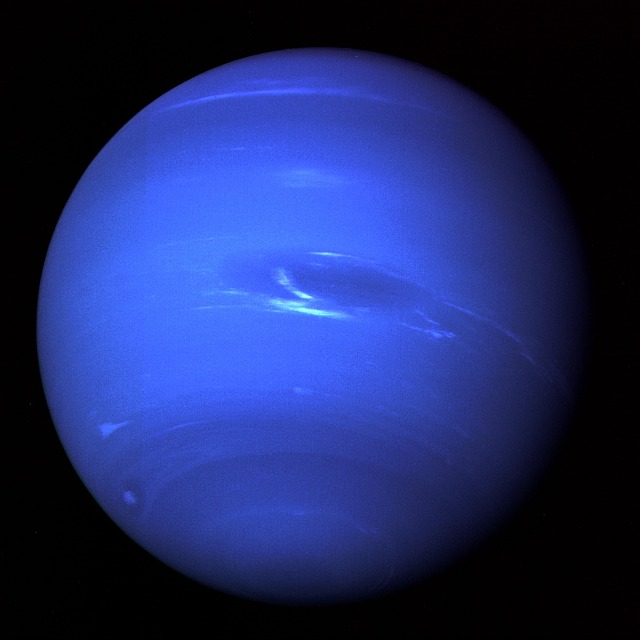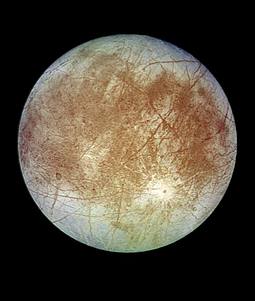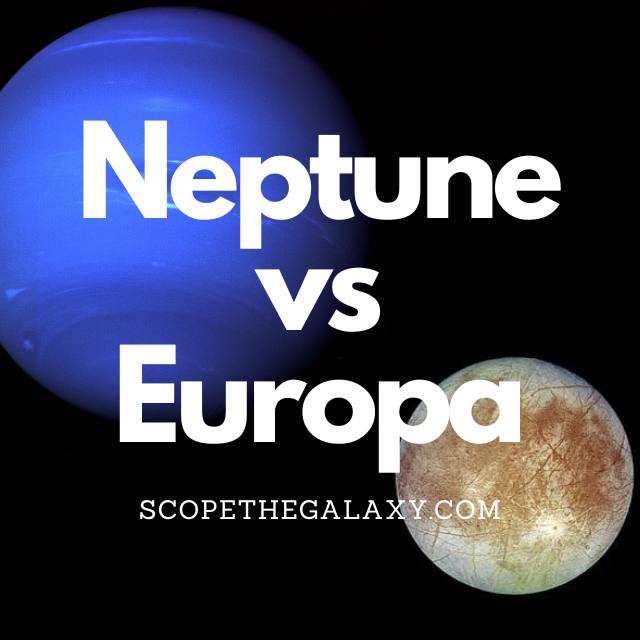*This post may contain affiliate links. This means we may make a commission if you purchase an item using one of our links*
The main differences between Neptune and Europa is that Neptune is an ice giant that orbits the Sun in 165 years, has 14 moons and has the fastest wind speeds in our solar system averaging 2,000 km/h whilst Europa is a natural satellite that is 1 out of the 79 moons that orbit Jupiter, is tidally locked to the gas giant and has water ice on its surface.
There are various other differences between these two celestial objects so continue reading for a more thorough breakdown of Europa and Jupiter below along with similarities and differences.
What Is The Planet Neptune?
Table of Contents

Neptune is the 8th farthest planet from the Sun and ranks among the bigger planets in our solar system. As the 8th farthest planet from the Sun, it does take Neptune a very long time to complete 1 orbital around the Sun.
This takes 165 years to complete which in comparison to the 16 hour 1 full spin around the axis is a massive difference.
In regards to its composition, Neptune is mostly made up of a thick swath of water closer to the center, methane, ammonia, hydrogen and helium molded around its Earth sized core.
As a result of the excess amount of methane and the inclusion of another undiscovered element within the atmosphere, Neptune’s color is a far deeper blue than the likes Uranus, which also has an abundantly methane based atmosphere.
The planet is 49,244km in diameter, making it roughly 4 times Earth’s diameter Earth, and would allow around 57 Earths to fit inside it. This also makes Neptune the 4th largest planet in our solar system.
Neptune is very cold mostly down to its distance from the Sun, where its atmospheric temperature sits between -220 to -230 degrees Celsius. Its core is far hotter coming in at 5,100 degrees Celsius and is the very likely cause for the liquid water present within the planet
Subsequently, the erratic temperature and gaseous composition of Neptune, is what constitute towards its turbulent behavior.
In fact Neptune has the fasted winds in our solar system, producing some that eclipse speeds of 2,000km per hour. The fastest winds on Earth would only be a fifth of these speeds at most.
At this moment in time we have discovered 14 moons orbiting Neptune and have also observed 5 thinner rings surrounding the ice giant.
What Is The Moon Europa?

Europa is the smallest of the Galilean moons, first discovered on 8th January 1610. The surface of this icy world is frozen, but scientists believe a watery ocean could lie beneath the surface. And in 2012, researchers found a possible water plume in the Southern polar region of Europa.
This research is yet to be confirmed; still, it gives us reasonable grounds to hypothesize that water could exist on this icy moon.
Estimates place Europa at around 4.5 billion years old (the same age as its planet, Jupiter), and its average distance from the Sun is approximately 780 million km.
It has a diameter of 3,121.6km, which makes it larger than Pluto but smaller than the Earth’s moon, and the maximum temperature is a chilly -160 degrees Celsius. In regards to mass, it measures in around 4.8 × 10^22 kg.
Europa takes three-and-a-half days to orbit its planet at an average distance of 670,900km, and it is tidally locked, meaning the same side of the moon always faces Jupiter.
Among the fascinating features of this ice moon is its incredibly reflective nature. The icy crust of this body provides a light reflectivity of 0.64 – the highest of any moon in the solar system.
Data from the Galileo spacecraft suggests that Europa is composed of an iron core, rocky mantle, and silicate rock (a similar composition to Earth).
The moon’s surface is covered in cracks, which many theorize could result from tidal currents beneath the surface. It is this potential of water – and of life – that keeps astronomers so interested in this moon.
Europa might be small, but astronomers estimate it holds two to three times more water than the Earth. In addition, this moon possesses the essential elements for life, such as carbon, oxygen, hydrogen, and nitrogen.
There may be no solar energy on this moon, but hydrothermal vents could provide energy, and tidal heating from Jupiter could provide a heat source and keep the moon stable enough for life to form. In addition, the liquid ocean is well protected from radiation from thick, icy surfaces.
Similarities Between Neptune And Europa
Neptune and Europa don’t have too many similarities but some elements are still shared, which in this case includes the below:
- Both are a spherical shape.
- Both have a hotter core.
- Both also orbit another entity.
- Neither have tectonic plates.
- Both are part of the same solar system.
Differences Between Neptune And Europa
in regards to the differences between the two, they include the following:
- Europa is a natural satellite that orbits Jupiter whilst Neptune is a gas based ice giant that orbits the Sun
- Neptune is the 8th farthest planet from the Sun whilst Europa is joint 5th as it orbits Jupiter. As a result it takes Neptune 165 years to orbit the Sun whilst Europa completes an orbit in roughly 12 years.
- Neptune has 14 moons whilst Europa has 0.
- A Europa day is 3.5 days whilst a day on Neptune is 16 hours.
- Europa is tidally locked to Jupiter whilst Neptune is not tidally locked to anything.
- Neptune’s average temperature is -220 to -230 degrees Celsius whilst Europa’s average temperature is -160 degrees Celsius.
- Europa’s surface consists of water ice among other rocks, with a non-existent atmosphere whilst Neptune is a gas based ice giant with an atmosphere consisting mostly of hydrogen, helium and methane, which is what contributes to its deep blue color along with a thick swath of water closer to the center.
- Neptune is the bigger of the two with a diameter of 49,244km whilst Europa’s diameter is 3121.6km.
- Neptune’s mass is 1.024 × 10^26 kg whilst Europa’s mass is 4.8 × 10^22 kg.
- Europa has an axial tilt of 0.1 degrees whilst Neptune’s axial tilt is 28 degrees.
- Neptune’s density is 1.64 g/cm³ whereas Europa’s density is 3.01 g/cm³.
- Europa’s gravity is 1.315 m/s² whilst Neptune’s gravitational strength is said to be 11.15 m/s².
- Neptune orbits the Sun in a circular pattern whilst Europa orbits Jupiter in an elliptical pattern.
- Neptune has the fastest wind speeds in the solar system averaging 2,000 km/h
Summary
Even though Neptune and Europa are part of the same solar system, there are a large variety of differences between these two as one is a planet and the other is a natural satellite.
Other than this, whether it be in regards to size, temperature, mass, composition and beyond, these celestial entities are very distinct from one another and ultimately function uniquely from one another too.

